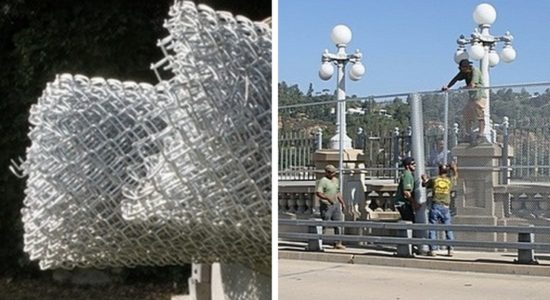
Pasadena’s City Manager has ordered the immediate installation of temporary fencing along the entire length of the Colorado Street Bridge in an effort to curb suicides at the historic structure.
In response to a wave of jumps and attempts, City Manager Steve Mermell exercised his authority under the City’s municipal code to make an emergency purchase.
“Across the country, suicides are increasing, and we’ve seen an increase here locally,” Mermell said. “As it relates to the Colorado Street Bridge, there were nine suicides from that location in 2017.”
“In the interests of public safety, on an emergency basis as set forth in Pasadena Municipal Code Section 4.08.150, there will be an extension of the alcove fencing the entire length of the bridge and we will close off the ends as best as possible to prevent people from walking out from the end of [the] bridge,” he said.
Mermell said “this should take place starting this week.”
In the most recent incident, authorities talked a woman down from the bridge Monday after 13 hours of negotiations.
The City has formed a task force to look into finding a long-term solution to the problem. But Mayor Terry Tornek said immediate action is required.
“We can’t wait for another year while we grind our way through the approval process and funding process. We need to do something,” he said. “It’s an emergency and we need to intervene right now.”
It will cost several hundred thousand dollars, the Mayor said.
“It’s going to be very unattractive. People are going to be unhappy about the appearance,” Tornek said. “The aesthetic issue is trumped by the public safety issue, and the humanitarian issue. And so I think [Mermell] is right. We need to take action.”
Over a year ago in July 2017 the City installed temporary emergency 10-foot-tall fencing made of 1-inch mesh at each of the 20 alcoves that line the Colorado Street Bridge and undertook more intensive efforts to find a complete permanent solution.
More than 150 people have jumped from the bridge since the Great Depression, according to City officials. More than half of the suicides took place during the 1930s.
More than 30 suicides have been reported since 2006, with most originating from the alcoves along the bridge, where access over the existing metal railing is easier. Dozens more people have been successfully talked down from the bridge by authorities.
“The bridge is a tremendous source of pride and satisfaction for the City. And yet at the same time, it’s a source of these tragedies,” Tornek said. “Each one of the lives lost is a tragedy.”
Vice Mayor John Kennedy said the iconic status of the bridge needs to be taken into account in the long-term solution.
“The barriers must be such that we can reduce to almost zero the possibility of someone jumping from the Colorado Street Bridge, measured against the historic nature of the bridge itself,” he said.
With enough money and modifications, there are ways to essentially eliminate bridge suicides, according to Kennedy.
“You enclose and encase the whole bridge with a cross-sectional metal netting that makes it impossible for someone to jump from the bridge,” he said. “The cost to do so is significantly high, and maybe too cost prohibitive for the voters and residents, but there is a way to make it absolutely impossible to jump from the bridge.”
Officials used such an approach at the Prince Edward Viaduct in Toronto, Canada. It saw nearly 500 suicides between 1918 and 2003, when the barriers were installed, according to a City staff report. Suicides fell to zero following the installation of the system.
But structural modification isn’t the only way to combat the problem.
Kennedy credited the Police Department’s special teams — which include the Homeless Outreach and Psychiatric Evaluation Team and the Crisis Negotiation Team — for their efforts, and successes.
“Their work is critical, not only with counseling those who are attempting to end their life by suicide, but others who are in the community and have mental issues,” he said. “They have been an extraordinarily important tool.”


















